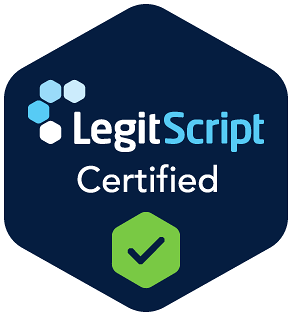Fentanyl Addiction Treatment in New Jersey: Addiction Signs, Symptoms, and Treatments
Maybe a pain prescription ran out and street pills seemed harmless, or perhaps curiosity led to that first blue tablet everyone swore was “just like oxy.” Even so, fentanyl is a different beast: a synthetic opioid so powerful that a few salt grains can stop breathing. [1]
Once it takes hold, every corner of life starts orbiting the next dose, and New Jersey headlines about overdose deaths suddenly feel personal. If that sounds familiar, know that real, evidence-based help exists, and a new story can start today.
Key Points
- Fentanyl detox requires 24/7 medical supervision. Rapid-onset withdrawal symptoms can become life-threatening without trained clinicians and medication support.
- The Garden offers a full continuum of care so clients can step down safely while building recovery skills.
- Medication-Assisted Treatment (MAT) cuts through cravings and lowers the risk of overdose, giving the brain time to heal while therapy does its work.
- Dual-diagnosis care addresses underlying mental health issues like anxiety, PTSD, or depression that often fuel opioid use.
- Aftercare planning, alumni groups, and sober-living referrals keep momentum strong long after an individual leaves the fentanyl rehab center, supporting true long-term recovery.
What Is Fentanyl?
Fentanyl is a synthetic opioid first approved for hospital use to ease severe pain after surgery or during advanced cancer care. On the medical side, it’s delivered in tightly dosed IV drips, patches, or lozenges and is listed as a Schedule II controlled substance, legal only when prescribed and closely monitored.
What makes fentanyl so risky outside that setting is its sheer potency: about 100 times stronger than morphine and 50 times stronger than heroin, meaning just a few milligrams (roughly a couple of grains of table salt) can slow breathing to a stop. [2] Illicit labs now mass-produce powder and pressed “M-30” tablets that look like familiar pain pills but contain unpredictable, often lethal, doses.
The human cost is staggering. In 2023 alone, nearly 73,000 people in the United States died from overdoses involving synthetic opioids like fentanyl—a number that keeps this drug at the center of America’s overdose crisis. [3]
Fentanyl Addiction & Abuse
When fentanyl reaches the brain, it latches onto opioid receptors and unleashes a flood of dopamine, the chemical behind pleasure and reward. [4] That surge feels euphoric in the moment, but it also rewires the brain to expect the next hit.
Over time, the body slows its dopamine production, so everyday joys barely register while cravings for fentanyl feel urgent, even life-or-death.
Addiction often starts innocently: a legitimate prescription for post-surgery pain, a friend sharing leftover pills, or counterfeit tablets sold as oxycodone. [5] Because fentanyl delivers such an intense rush, people already misusing opioid painkillers may “graduate” to it for a stronger high.
At the same time, newcomers may not realize that a single pressed pill can be fatal. Risk rises further when there’s a substance use disorder, untreated mental health issues, or a family history of addiction. [6]
Repeated use quickly locks many people into a cycle of tolerance, withdrawal, and escalating doses. Without help, like medical detox, evidence-based therapy, and long-term aftercare, the trajectory often points toward overdose deaths instead of recovery.
Take the first step towards recovery.
Our representatives are standing by to help you start healing today.
Signs, Symptoms & Health Risks
Early on, fentanyl may look like drowsiness or pinpoint pupils. Miss a dose, though, and acute withdrawal symptoms kick in, including chills, bone-deep aches, GI cramps, then severe pain and anxiety that can push someone back to use within hours, furthering the cycle of addiction. [7]
People with untreated depression, PTSD, or other mental health issues often find their cravings sharper, creating a high rate of dual diagnosis cases. [8] Add the constant fear of counterfeit pills, and every use becomes a coin toss with life-threatening odds.
Fentanyl Withdrawal Timeline
- 8–12 hours: Anxiety, yawning, sweating, and muscle pain
- 24–48 hours: Nausea, vomiting, severe cramps, insomnia, gooseflesh
- 3–5 days: Peak symptoms: elevated heart rate, intense cravings, restless legs
- 6–10 days: Gradual decline, lingering fatigue, or depression
Quitting cold turkey at home is dangerous.[9] Vitals are monitored every few hours, IV fluids replace lost electrolytes, and staff are on standby for complications such as high blood pressure or dehydration.
Levels of Care for Fentanyl Addiction Treatment
Once medically stable, clients transition into our comfortable outpatient treatment facility for their personalized fentanyl addiction treatment plan. Therapies may include cognitive behavioral therapy, skill-building, dialectical behavior therapy, emotion-regulation groups, and psychoeducation on relapse science. The goal: reset daily rhythms while uncovering the mental or environmental triggers that kept fentanyl in charge.
Healing is most effective when support is tapered gradually.
- Detox – The Garden’s partner medical detox facilities for fentanyl keep clients under 24/7 nursing care while board-certified physicians tailor a taper or comfort-medication plan.
- Partial Care (PC) – Six hours a day, five days a week. Clients practice coping skills in real time and still sleep in their own beds.
- Intensive Outpatient Program (IOP) – Three-hour evening or morning sessions allow individuals to work or study while remaining connected to therapy three to four days a week.
- Standard Outpatient – Weekly check-ins, medication management, and crisis coaching via secure video.
- MAT – Buprenorphine or a short naltrexone bridge eases symptoms and stabilizes vital signs so clients can focus on healing rather than fighting pain or panic. [10]
At every stage, clinicians match the level of care to progress, switching tracks quickly if symptoms flare.
Medication-Assisted Treatment (MAT) & Craving Control
Contrary to common thinking, MAT isn’t “trading one drug for another.” Medications like extended-release buprenorphine quiet receptors enough for clear thinking, while naltrexone blocks the euphoric effect if someone uses it again.
Studies show MAT cuts fentanyl use, halves relapse risk, and lowers overdose deaths. [11] Clients combine medication with therapy and gradually taper only when stable supports like housing, employment, and mental health care are in place.
Relapse Prevention, Aftercare & Sober Living
Recovery doesn’t end at discharge. Each person leaves with a written aftercare program, which includes weekly counseling, urine screens, and a relapse-response plan that identifies triggers and emergency contacts.
The team links clients to vetted sober-living homes for added structure, plus community resources like SMART Recovery, NA, or trauma-informed yoga collectives. Coping-skills workshops—such as budgeting, meal preparation, and job coaching—bridge the gap between treatment and everyday life.
Choosing a Fentanyl Rehab Center in New Jersey
Licensing matters, so look for facilities authorized to dispense MAT and staffed by nurses 24/7. Ask how they manage medical complications, whether therapists are trauma-trained, and how they coordinate with psychiatric providers for dual-diagnosis cases.
Families should tour the campus, review client-to-staff ratios, and verify whether overdose-response kits (such as naloxone) are on-site. Red flags include one-size-fits-all schedules, hidden costs, or guarantees of a “cure.”
Frequently Asked Questions About Fentanyl Addiction Treatment in New Jersey
How long does fentanyl detox take?
Most people feel the first withdrawal twinges 8–12 hours after their last use. The peak, when chills, cramps, and cravings are strongest, typically occurs around days 3–5, and acute symptoms usually taper by days 7–10. [12] Everyone’s timeline is different, but trusted detox medical teams monitor clients 24/7 until their vitals are stable and they can move safely to the next level of care.
What medications ease withdrawal?
Board-certified physicians may prescribe buprenorphine to settle receptors and curb cravings or use a short naltrexone bridge once opioids are out of the system. [13] Comfort medications, such as anti-nausea agents, non-addictive sleep aids, and electrolyte IVs, round out the protocol, allowing clients to focus on healing rather than pain.
Can I enter PHP without inpatient?
Yes—if you’ve already completed a medically supervised detox and your vitals, housing, and support system meet safety criteria. Our admissions team conducts a same-day assessment to confirm PHP is the right starting point or to recommend a brief residential stay first.
Does MAT replace counseling?
No. Medication-Assisted Treatment quiets the physical fire so the real work, like CBT, DBT, group therapy, and relapse-prevention planning, can take hold. We review the MAT plan regularly and taper only when coping skills and support networks are solid.
How does The Garden handle dual diagnosis?
Every client receives a psychiatric evaluation on the first day. Integrated teams of therapists, addiction specialists, and psychiatrists coordinate care, adjusting medications and therapy tracks so mental-health conditions like anxiety, PTSD, or depression heal alongside substance use disorder.
Sources
[1] [4] Fentanyl. (2025, June 6). National Institute on Drug Abuse. https://nida.nih.gov/research-topics/fentanyl#addictive
[2] Fentanyl. (n.d.). DEA. https://www.dea.gov/factsheets/fentanyl
[3] FastStats. (n.d.). Drug Overdoses. https://www.cdc.gov/nchs/fastats/drug-overdoses.htm
[5] Prescription Opioids DrugFacts | National Institute on Drug Abuse. (2023, May 25). National Institute on Drug Abuse. https://nida.nih.gov/publications/drugfacts/prescription-opioids
[6] Morales, A. M., Jones, S. A., Kliamovich, D., Harman, G., & Nagel, B. J. (2019). Identifying Early Risk Factors for Addiction Later in Life: a Review of Prospective Longitudinal Studies. Current Addiction Reports, 7(1), 89–98. https://doi.org/10.1007/s40429-019-00282-y
[7] Luba, R., Jones, J., Choi, C. J., & Comer, S. (2022). Fentanyl withdrawal: Understanding symptom severity and exploring the role of body mass index on withdrawal symptoms and clearance. Addiction, 118(4), 719–726. https://doi.org/10.1111/add.16100
[8] Co-Occurring disorders and other health conditions. (n.d.-e). https://www.samhsa.gov/substance-use/treatment/co-occurring-disorders
[9] Shah, M., & Huecker, M. R. (2023, July 21). Opioid withdrawal. StatPearls – NCBI Bookshelf. https://www.ncbi.nlm.nih.gov/books/NBK526012/
[10][11][13] Deyo-Svendsen, M., Svendsen, M. C., Walker, J., Hodges, A., Oldfather, R., & Mansukhani, M. P. (2020). Medication-Assisted treatment for opioid use disorder in a rural family medicine practice. Journal of Primary Care & Community Health, 11. https://doi.org/10.1177/2150132720931720
[12] Opiate and opioid withdrawal: MedlinePlus Medical Encyclopedia. (n.d.). https://medlineplus.gov/ency/article/000949.htm



